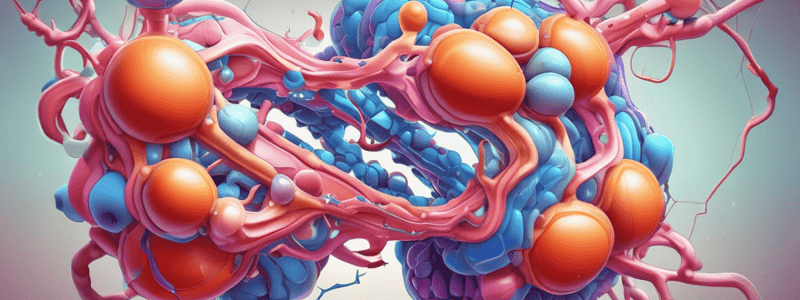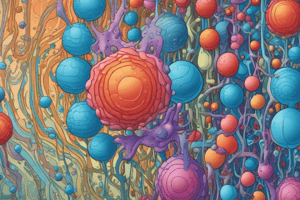Podcast
Questions and Answers
What is the type of bonds that anchor proteins to the membrane?
What is the type of bonds that anchor proteins to the membrane?
- Ionic bonds
- Hydrogen bonds
- Van der Waals bonds
- Covalent bonds (correct)
Which type of protein is deeply embedded in the bilayer?
Which type of protein is deeply embedded in the bilayer?
- Peripheral protein
- Integral membrane protein (correct)
- Extrinsic protein
- Anchored protein
What is the function of phospholipase A1?
What is the function of phospholipase A1?
- To break down the membrane structure
- To synthesize new phospholipids
- To catalyze the formation of fatty acid chains
- To hydrolyze the sn-1 position of phospholipids (correct)
Which of the following treatments would remove both peripheral and anchored proteins from the membrane?
Which of the following treatments would remove both peripheral and anchored proteins from the membrane?
What is the name of the enzyme that is anchored to the cell surface by a glycolipid chain?
What is the name of the enzyme that is anchored to the cell surface by a glycolipid chain?
Which of the following types of membrane proteins are involved in the maintenance of ionic gradients and transmission?
Which of the following types of membrane proteins are involved in the maintenance of ionic gradients and transmission?
What is the term used to describe the flexible and dynamic structure of cell membranes?
What is the term used to describe the flexible and dynamic structure of cell membranes?
What is the effect of high cholesterol content on the fluidity of the lipid bilayer?
What is the effect of high cholesterol content on the fluidity of the lipid bilayer?
Which type of protein interacts with the polar head group of phospholipids?
Which type of protein interacts with the polar head group of phospholipids?
What is the characteristic feature of lipid rafts?
What is the characteristic feature of lipid rafts?
Which of the following is an example of a receptor protein involved in signal recognition and transmission?
Which of the following is an example of a receptor protein involved in signal recognition and transmission?
What is the name of the signalling G-protein that is anchored to the membrane by a fatty acid chain?
What is the name of the signalling G-protein that is anchored to the membrane by a fatty acid chain?
What is the effect of kinks in unsaturated fatty acids on the fluidity of the lipid bilayer?
What is the effect of kinks in unsaturated fatty acids on the fluidity of the lipid bilayer?
What is the function of integral proteins in the lipid bilayer?
What is the function of integral proteins in the lipid bilayer?
What is the effect of short chain fatty acids on the fluidity of the lipid bilayer?
What is the effect of short chain fatty acids on the fluidity of the lipid bilayer?
What is the characteristic feature of enzymes as a type of membrane protein?
What is the characteristic feature of enzymes as a type of membrane protein?
What is the primary function of the 'polar head group' in phospholipids?
What is the primary function of the 'polar head group' in phospholipids?
Which of the following lipids is NOT a major component of all membranes?
Which of the following lipids is NOT a major component of all membranes?
What is the main difference between the outer mitochondrial membrane and the inner mitochondrial membrane in terms of composition?
What is the main difference between the outer mitochondrial membrane and the inner mitochondrial membrane in terms of composition?
What is the term used to describe the arrangement of proteins and lipids in a membrane?
What is the term used to describe the arrangement of proteins and lipids in a membrane?
Which of the following is an example of an amphipathic molecule?
Which of the following is an example of an amphipathic molecule?
What is the primary function of cholesterol in membranes?
What is the primary function of cholesterol in membranes?
Which of the following is a characteristic of membrane proteins?
Which of the following is a characteristic of membrane proteins?
What is the term used to describe the movement of lipid molecules within the plane of the membrane?
What is the term used to describe the movement of lipid molecules within the plane of the membrane?
Which of the following lipids is often found on the outer surface of the plasma membrane?
Which of the following lipids is often found on the outer surface of the plasma membrane?
What is the term used to describe the difference in lipid composition between the two halves of a lipid bilayer?
What is the term used to describe the difference in lipid composition between the two halves of a lipid bilayer?
Flashcards are hidden until you start studying
Study Notes
Composition of Membranes
- Phospholipids are the major components of all membranes, which form a bilayer in an aqueous environment.
- Phospholipids consist of a polar head group attached to a glycerol backbone through a phosphate group, with two fatty acyl side chains linked to the glycerol backbone via ester bonds.
- Phospholipids are amphipathic, having a polar head group and non-polar fatty acid tail.
Fluid Mosaic Model of Membrane Structure
- The fluid mosaic model describes the structure of membranes as "islands of protein in a sea of lipid".
- This model consists of a lipid bilayer with embedded proteins.
Variation in Composition of Cellular Membranes
- Different cellular membranes have varying compositions of carbohydrates, proteins, and lipids.
- The plasma membrane has a protein:lipid ratio of 1:1, while the outer mitochondrial membrane has a ratio of 1:1, and the inner mitochondrial membrane has a ratio of 3:1.
- The nuclear membrane has a protein:lipid ratio of 3:1, with a high concentration of cholesterol (10%).
Asymmetry of Lipid Bilayers
- Lipid bilayers are asymmetrical, with two halves having different lipid compositions.
- PC and SPH face the extracellular environment, while PS and PE face the cytosolic side.
Membrane Fluidity
- Membrane fluidity is the ease with which lipid molecules move about in the plane of the bilayer.
- Fluidity is important in regulating membrane function, such as movement of proteins, signalling, and exocytosis.
Regulation of Fluidity
- Lipid composition defines membrane fluidity.
- Increase in short-chain fatty acids reduces van der Waals interactions and increases fluidity.
- Kinks in unsaturated fatty acids reduce van der Waals interactions with other lipids and increase fluidity.
- High cholesterol content restricts the random movement of polar heads, orders the lipid bilayer, and decreases fluidity.
Lipid Rafts
- Lipid rafts are specialised membrane microdomains that are more ordered and less fluid.
- Lipid rafts have increased levels of cholesterol, sphingomyelin, and gangliosides.
- Lipid rafts allow close interaction between receptors and signalling molecules.
Types of Membrane Proteins
- Structural proteins maintain cell-cell contact and attachment of the cytoskeleton to the membrane.
- Receptor proteins participate in signal recognition and transmission.
- Ion channels maintain ionic gradients and transmission.
- Transporters import and export substrates.
- Enzymes catalyse reactions.
Organisation of Membrane Proteins
- Integral proteins are embedded in the lipid bilayer, with transmembrane spanning domains as α-helices or β-sheets.
- Anchored proteins are covalently linked to fatty acid chains or glycolipids.
- Peripheral proteins attach to the membrane surface by ionic interactions with integral proteins or polar head groups of phospholipids.
Removal of Proteins from Membranes
- High salt, urea, and detergents can remove peripheral proteins from membranes.
- Phospholipases can selectively hydrolyse components of phospholipids and remove anchored and integral proteins.
Studying That Suits You
Use AI to generate personalized quizzes and flashcards to suit your learning preferences.




